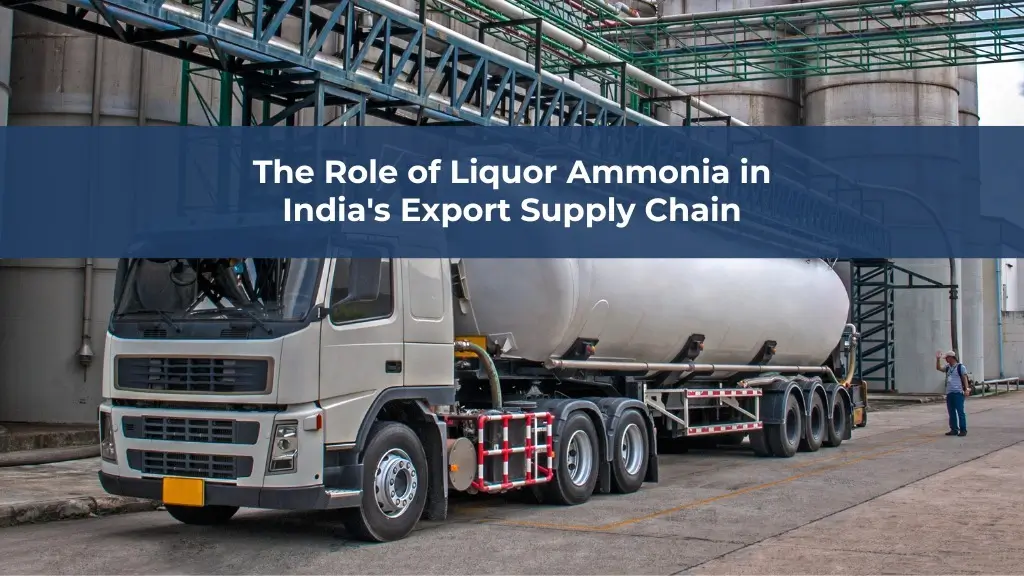In the evolving landscape of clean energy and sustainable chemicals, ammonia has emerged as a critical player — not just in fertilizers and manufacturing, but as a potential energy carrier for the future. For India, which is rapidly advancing toward self-reliance in industrial production, the export potential for ammonia, particularly green ammonia, is enormous.
With the government’s focus on renewable energy, strategic trade policies, and growing global demand for low-carbon fuels, the stage is set for India to become a leading hub for green ammonia transporters and exporters.
Discover our role in green ammonia transportation.
Why the World Is Turning to Green Ammonia
As nations transition from fossil fuels to renewable energy, the challenge lies in storing and transporting clean power efficiently. Hydrogen has been a key candidate, but its gaseous form makes it difficult to store and move over long distances.
This is where green ammonia steps in. Ammonia, composed of nitrogen and hydrogen, can be liquefied at moderate pressures and easily transported in existing infrastructure. More importantly, it is carbon-free at the point of use and can be reconverted into hydrogen or used directly as a clean fuel source.
As a result, global demand for green ammonia is expected to surge — particularly in Europe, Japan, and South Korea, where governments are pushing for renewable imports to meet net-zero targets.
India’s Strategic Advantage
India’s potential to lead in green ammonia exports is backed by three key factors:
- Abundant Renewable Resources:
With vast solar and wind capacity, India has a natural advantage in generating the renewable electricity required for green ammonia production. - Government Policies and Incentives:
Under the National Green Hydrogen Mission, the government aims to produce 5 million metric tonnes (MMT) of green hydrogen annually by 2030 — a large portion of which can be converted into ammonia for export. - Growing Industrial Expertise:
Established ammonia producers and green ammonia transporters in India, like Jaysons Chemical Industries, are investing in research, safety, and infrastructure to ensure reliable and sustainable ammonia logistics.
Global Demand and Export Opportunities
The international ammonia trade is shifting. While grey ammonia (produced using fossil fuels) dominates today, importers are setting clear carbon benchmarks.
Countries such as Japan, Germany, and the Netherlands are already entering long-term agreements with global suppliers for green ammonia imports. India’s proximity to key trade routes, including the Suez Canal and Indo-Pacific shipping lanes, positions it perfectly for efficient export operations.
The sectors most likely to drive green ammonia demand include:
- Maritime fuel (for decarbonizing global shipping)
- Power generation (as a hydrogen carrier)
- Fertilizer manufacturing (transitioning to low-carbon feedstock)
Export Readiness: Infrastructure and Logistics
Exporting ammonia, particularly green ammonia, requires a robust and safe infrastructure. This includes liquefaction units, cryogenic storage, and specialized transport systems.
India already has significant experience in handling and transporting ammonia for domestic use. Expanding this infrastructure for green ammonia exports involves upgrading facilities to meet international standards for purity, containment, and sustainability.
Below is a comparative overview of the factors influencing India’s ammonia export landscape:
| Factor | Current Status | Future Outlook (2030) |
|---|---|---|
| Renewable Power Availability | Rapidly expanding solar and wind installations | Expected to exceed 500 GW capacity |
| Ammonia Production Capacity | Established grey ammonia base with expanding green capacity | Integration of electrolysers and renewable feedstock |
| Export Infrastructure | Limited to traditional fertilizer and chemical terminals | Upgrading to green ammonia-compatible export hubs |
| Regulatory Support | Strong policy push under Green Hydrogen Mission | Likely introduction of export subsidies and carbon credits |
| Market Demand | Emerging interest from Japan, EU, and Middle East | Projected 200% growth in global demand for green ammonia |
This steady evolution from conventional to renewable ammonia logistics is setting the stage for India’s emergence as a key supplier in the global low-carbon economy.
The Role of Green Ammonia Transporters in India
As production scales up, green ammonia transporters will play a critical role in ensuring safety, reliability, and efficiency. Transporting green ammonia requires:
- Specialized tankers and tonners with pressure-rated containment systems
- Temperature-controlled handling to prevent evaporation losses
- Compliance with international safety and environmental standards
Companies like Jaysons Chemical Industries are at the forefront of these developments — leveraging decades of experience in ammonia logistics, cylinder maintenance, and regulatory compliance to adapt for the future of green ammonia movement.
Their integrated service model — spanning production, storage, degassing, transportation, and regulatory approvals — makes them a trusted name among green ammonia transporters in India, poised to support both domestic and export markets.
Policy and Trade Outlook
The Indian government’s forward-thinking policies, coupled with growing private investment, indicate a bright future for ammonia exports. Key initiatives include:
- Incentives for renewable-based chemical manufacturing
- Support for ammonia bunkering ports
- Export corridors connecting India to Europe and East Asia
As global carbon regulations tighten, buyers will increasingly prefer ammonia produced using verified renewable energy sources, creating a premium market for green exports.
Conclusion
The transformation of India’s ammonia industry reflects a broader energy revolution. From traditional fertilizer feedstock to a globally traded carbon-free fuel, ammonia is redefining industrial chemistry and clean logistics.
With expertise, innovation, and government backing, green ammonia transporters in India are positioned to play a leading role in this transition — turning India into not just a producer, but a global leader in sustainable ammonia exports.













